The complete guide to customer loyalty in eCommerce

PwC’s 2022 customer loyalty survey found that more than a quarter of respondents ditched a brand for a competitor in the past year. Why? Bad experiences with products, services, or customer support.
Losing customers is pricey. Not only do businesses have to fix the experiences that make new customers churn, but they also have to invest in replacing those customers. According to CommerceNext’s 2022 report, approximately 61% of direct-to-consumer companies called increasing customer acquisition costs their greatest challenge to achieving 2022 revenue goals.
Rising customer acquisition costs mean you can’t stop trying to build customer loyalty in eCommerce, despite the volatility of customer behavior. By creating experiences that keep customers engaged, you reduce customer acquisition costs and create a group of advocates who do much of the acquiring for you.
What is customer loyalty?
Customer loyalty is the act of eagerly choosing one brand over another on a consistent basis.
It’s the result of a consistently positive customer experience and the perceived value of the product or service the customer receives. In other words, it’s an indicator of how likely your existing customer base is to continue to shop your online store and recommend your brand over time.
The more loyal customers you win, the less you have to worry about acquiring new ones.
How do customer loyalty and customer retention differ?
Business growth depends on customer retention and customer loyalty, but these concepts are not interchangeable. Customer retention is usually a stop on the way to customer loyalty.
Retained customers are happy to buy from you repeatedly, until a competitor offers them a better deal or a more effortless eCommerce experience. They may recommend you to a friend, but their enthusiasm for your brand only goes as far as your ability to meet an immediate need.
Loyal customers do more than buy from you repeatedly. They routinely recommend you to others and are likely to forgive you for the occasional mishap. Ready to find out how to build customer loyalty?
10 strategies for increasing customer loyalty in eCommerce
PwC’s survey found that 30% of customers today say they’re increasingly likely to try a new brand. Younger customers are even more brand agnostic. But if you adopt these strategies, you’re more likely to create advocates by increasing customer loyalty.
1. Make customer service a priority
Brand perception and customer service go hand in hand. Multiple positive encounters with empathetic, knowledgeable, efficient agents build a solid foundation for customer loyalty.
Zendesk found that 81% of customers say “a positive customer service experience increases the likelihood they’ll make another purchase.” A negative experience does the opposite — 61% say “they would switch to a company’s competitor” after a single bad support exchange.
To make sure every support experience is as positive as possible, you should:
- Train agents for success. Have a member of the product team educate agents on all items in your eCommerce inventory. For agents that struggle with difficult customers, offer empathy training modules.
- Invest in a customer service tool. Gorgias was built specifically for eCommerce stores. It integrates with Shopify, giving agents an overview of a customer’s order history. It also records every customer support interaction for future reference.
- Offer omnichannel support. Customers want to contact support on their preferred channels, whether that’s phone, email, SMS, or even Facebook Messenger. The Zendesk report shows 93% of customers will spend more with companies that give them this flexibility. Gorgias allows this level of support.
Actively seek feedback. Send a customer satisfaction survey after each support interaction — also on the customer’s preferred channel. If an agent’s performance is lacking, a survey can alert you to the situation before it negatively affects other customers.
2. Create personalized experiences
When customers interact with your brand, they expect those interactions to lead to more personalized communications. McKinsey found that 71% of consumers expect personalized interactions — and 76% get frustrated when they don’t get them.
Personalization builds customer loyalty by giving consumers what they want, when they want it, making their lives more convenient. For example, a customer who only buys tennis shoes might not have much use for a text message containing a promotion on dress shoes. Better yet, they’d prefer receiving a promo on tennis shoes at about the time their current pair wears out.
Ways to deliver personalization:
- Implement a guided selling experience. For example, check out Peet’s Coffee’s quiz. It leads shoppers to the coffee type that best matches their taste.
- Use data-driven recommendations. When a customer looks at or purchases a product while logged in to their account, use that data to personalize recommendations on their next visit. You may be able to cross-sell or upsell them on products they didn’t know they wanted.
- Segment your marketing list and tailor your communication. Use a CRM tool such as Klaviyo to record customer interactions at various touchpoints. If a customer abandons their shopping cart, for example, send an email or message a day later with a discount to encourage them to complete their purchase.
3. Implement a subscription experience
A subscription experience is one of the best ways for increasing customer loyalty in eCommerce. Today’s consumers crave convenience and cost savings — the two primary benefits of a subscription. In other words, the very nature of a subscription generates customer loyalty, as they make shoppers’ lives easier to manage.
Tips for a successful subscription model:
- Give subscribers as much control as possible. Your subscription software provider should provide customers with online portals where they can skip a shipment or swap one item out for another. Our research shows that when subscribers can skip an order, they stick with you 135% longer.
- Reward loyal subscribers. Show subscribers that you’re grateful for their commitment to your brand. KIND Snacks gives subscribers 50% off every fourth order.
Blog: Is a subscription-based business model right for your business?
4. Incorporate an eCommerce loyalty program
A customer loyalty program for eCommerce encourages customers to purchase more in exchange for specific rewards. These programs can enhance both a subscription and one-off eCommerce business.
eCommerce loyalty programs are either paid or free. Paid programs such as Amazon Prime are actually more likely to lead to loyalty than free ones. McKinsey found that paid loyalty program members are 60% more likely to increase spending after subscribing, which is twice as high as free programs. Paid loyalty programs also drive “higher purchase frequency, basket size, and brand affinity” than free programs.
Once you’ve chosen a paid or free loyalty program, decide how to structure your customer incentives.
Points-based loyalty program. The simplest and most popular eCommerce loyalty program format — customers collect points or “bucks” as they purchase or complete certain tasks. They redeem the points for discounts, free products, or other perks.
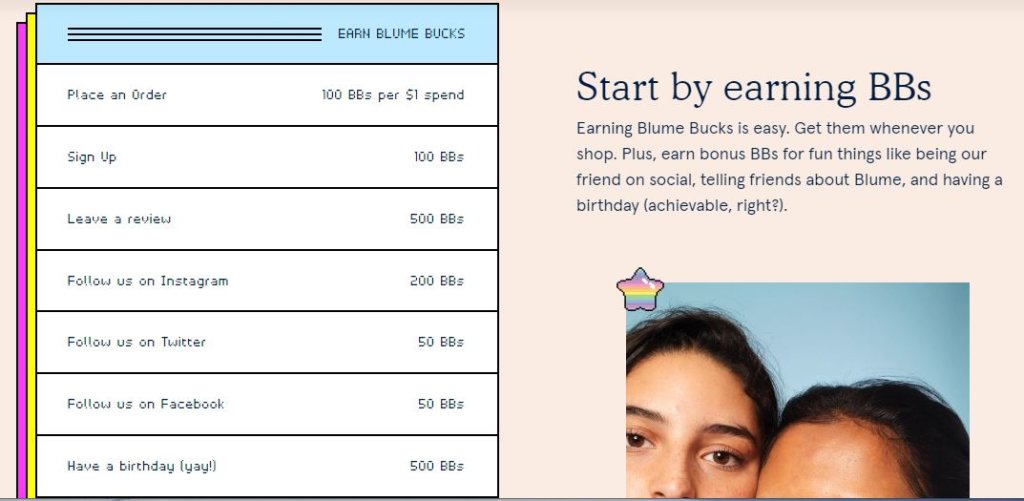
Tiered loyalty program. A tiered loyalty program resembles a points-based one, but here the quality and quantity of rewards go up in higher tiers.
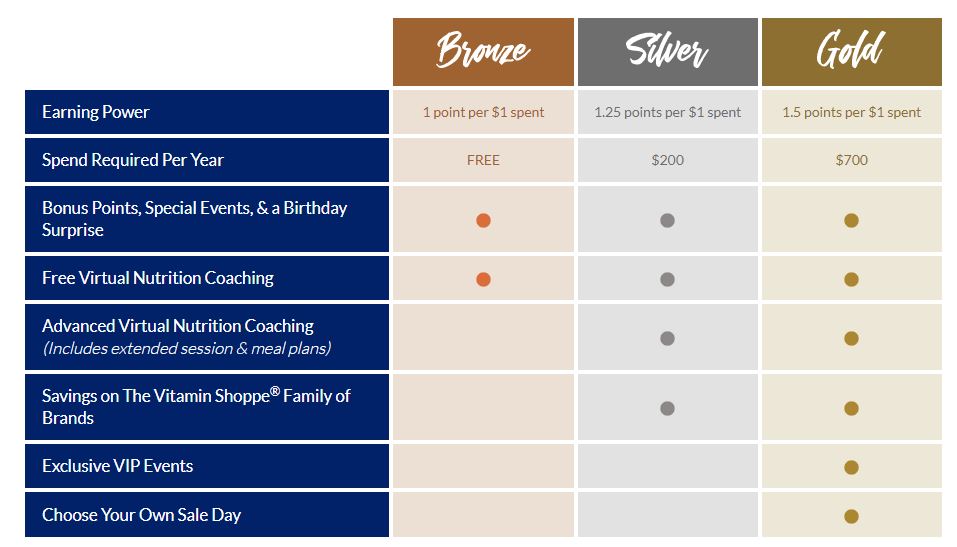
The Vitamin Shoppe, for example, requires minimum spends at the higher tiers to take advantage of the better perks.
Value-based loyalty program. Value-based programs reward customers by donating to meaningful causes. The more members spend, the more the company gives back.

TOMS gives its loyalty program members the option of redeeming their points for merchandise or for a donation to one of their “grassroots partners.”
Loyalty program tips:
- Make it easy for customers to earn and redeem points. If you make your rewards program too difficult to understand, it will work against customer loyalty, not for it. At checkout, alert customers how many points they stand to gain from a purchase and give them their points total in the purchase confirmation email.
- Encourage referrals. Reward returning customers with a certain number of points for referring a friend who ends up buying.
Blog: 5 types of rewards to add to your loyalty program
5. Commit to a cause your customers care about
Loyal customers commit to a brand for their values as much as for the quality of their products or services. According to the Havas Group’s 2021 Meaningful Brands Report, 73% of survey respondents believe brands must work for “the good of society and the planet.”
Customers will invest in brands that do more than pay lip service to social issues dominating the headlines. The same Havas Group study found that 53% of consumers are willing to spend more with brands that take a stand. However, if a brand doesn’t follow through or communicate the results of their activism, it will sacrifice that customer trust.
Tips for promoting a cause:
- Make your company’s values and mission clear. Don’t leave customers guessing about what you stand for. Reach out to organizations that support the most popular causes and figure out the best way to contribute to them. You might opt to donate a portion of each sale or make a larger annual donation.
- Update customers on your charitable work. Send an annual report to customers detailing your achievements with your chosen charity. Highlight the people you’ve helped on social media and in an email campaign. Devote a section of your website to the cause as well.
6. Nurture your customers with an onboarding experience
A well-paced, thorough onboarding makes a powerful first impression for first-time customers, laying the groundwork for customer loyalty. According to a 2021 survey from The Manifest, 46% of respondents would be more likely to increase their spending on products or services after satisfying onboarding experiences.
Onboarding isn’t just for B2B SaaS companies; eCommerce merchants with subscriptions, an eCommerce loyalty program, or a deep product catalog can use onboarding to immerse customers in their brand and their benefits.
An eCommerce onboarding experience might contain these steps:
- A welcome email. Include a personal welcome from the founder, links to product guides, tips for getting the most value out of a subscription program, or a link to a brief tutorial on using your mobile app. According to Klaviyo, welcome emails see “4 times the click rate and 23 times the conversion rate of regular marketing emails.”
- Opt-in permissions. Include a page where customers can opt in to SMS, emails, or push notifications. Don’t text a customer without prior approval, especially with the growing number of data privacy regulations.
- Upsell or cross-sell suggestions, plus relevant offers. Send an onboarding email or SMS with recommendations based on the product they just purchased. Include an offer to encourage a repeat purchase.
7. Embrace omnichannel eCommerce
Omnichannel communication is an important loyalty driver in customer support. But it’s also critical for growing loyalty through a seamless eCommerce shopping experience.
If customers see a dress on Instagram they like, why create friction by forcing them to visit your website to make a purchase? If they have to waste time searching for the dress, that’s yet another obstacle.
According to a 2021 joint study by Meta and GroupM, nearly half of US consumers agree that “brands that reach them through social media with relevant information can earn their loyalty over time.” This information includes product announcements and any charitable initiatives.
Tips for embracing omnichannel eCommerce:
Integrate your Shopify store with Instagram and Facebook. This integration allows you to sync your products with these platforms and give customers the option to check out without leaving their feeds.
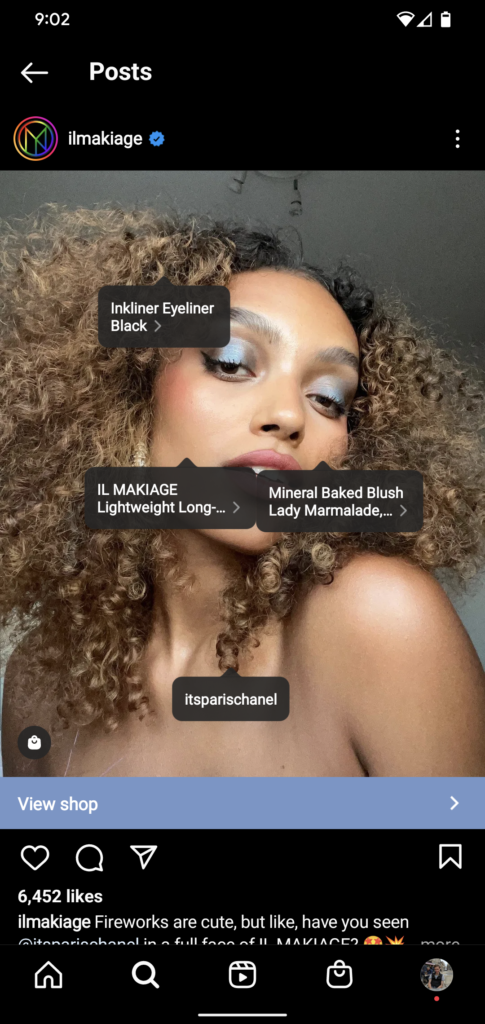
Incorporate SMS as a sales channel. Tools such as Attentive also integrate with top eCommerce platforms. Their 2021 Benchmark report found that 60% of marketers say SMS “significantly or overwhelmingly increased revenue generation.”
8. Elevate the post-purchase experience
Most of the hard work of growing eCommerce customer loyalty takes place after the initial purchase. Brands that meet customer expectations on issues such as shipping and returns have an advantage over those that focus more on the pre-purchase experience.
According to a 2020 survey from ReBOUND Returns and IMRG, a quarter of shoppers think a delay in processing their return contributes to a negative experience. As negative experiences add up, the risk of churn increases.
Tips to elevate the post-purchase experience:
- Integrate your email marketing platform with your logistics software. Communicate shipping updates to your customers in a timely manner, especially if there are any delays.
- Streamline returns and turn them into revenue drivers. Loop integrates with the biggest eCommerce sites, so customers can get refunds and even shop for other items directly from the Loop platform. Loop also has upsell options, potentially making a return the driver of more revenue than the initial purchase.
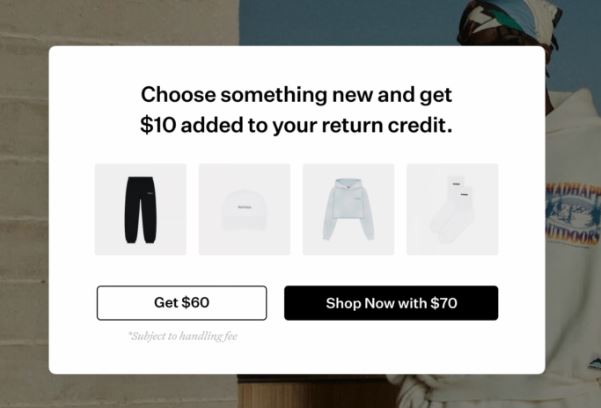
9. Be proactive about asking for and responding to feedback
When you ask customers for feedback — and respond to it, even when negative — you give them a sense of ownership of your brand and the experience you offer. Customer loyalty is frequently the result.
According to Joana de Quintanilha, VP and principal analyst at Forrester, “Contrary to popular belief, making customers feel content, happy, or delighted impacts loyalty less than making customers feel respected, understood, valued, or confident.”
Say a customer leaves a negative review on Facebook or Yelp. Not responding can do more harm than the review itself because it sends the message that you don’t value your customers’ opinions. BrightLocal found that “89% of consumers say they would be ‘fairly’ or ‘highly’ likely to use a business that responds to all reviews, positive and negative.”
Tips for encouraging customer feedback:
- Make it easy for customers to leave feedback. Use tools such as Medallia to insert surveys into eCommerce product pages to learn if customers are experiencing any friction.
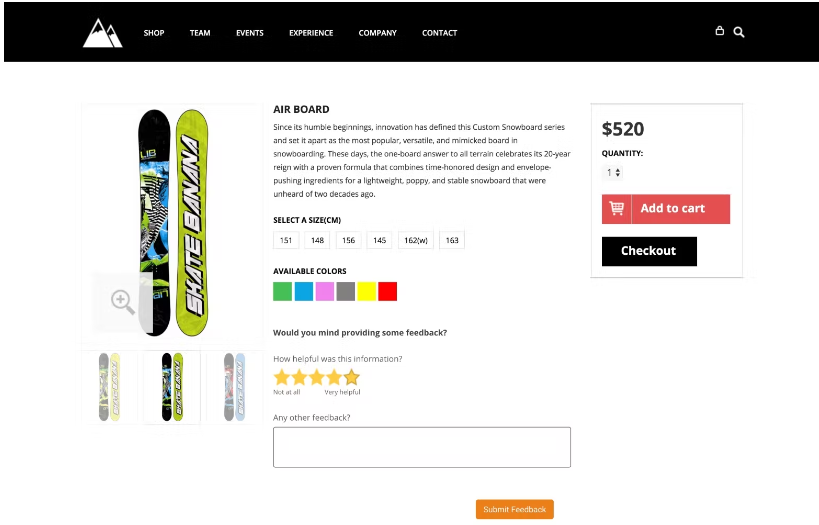
- Segment unhappy customers in your CRM. Unhappy customers need extra nurturing to win back their loyalty. Send them an email campaign that includes an apology, a discount on another purchase, and an update on how you plan to fix the problem that made them upset.
10. Build a community
One of the strongest ways to improve customer loyalty in eCommerce is by building an online community. According to Clarus Commerce’s 2022 Customer Loyalty Data Study, 22% of respondents say a “strong sense of community” encourages them to stick with a brand.
eCommerce fitness brand Lululemon partners with influencers, personal trainers, and yoga studios to build communities around their products. For example, in sponsoring and promoting an event with fitness expert Joe Wicks, Lululemon expanded their community to include his fans.
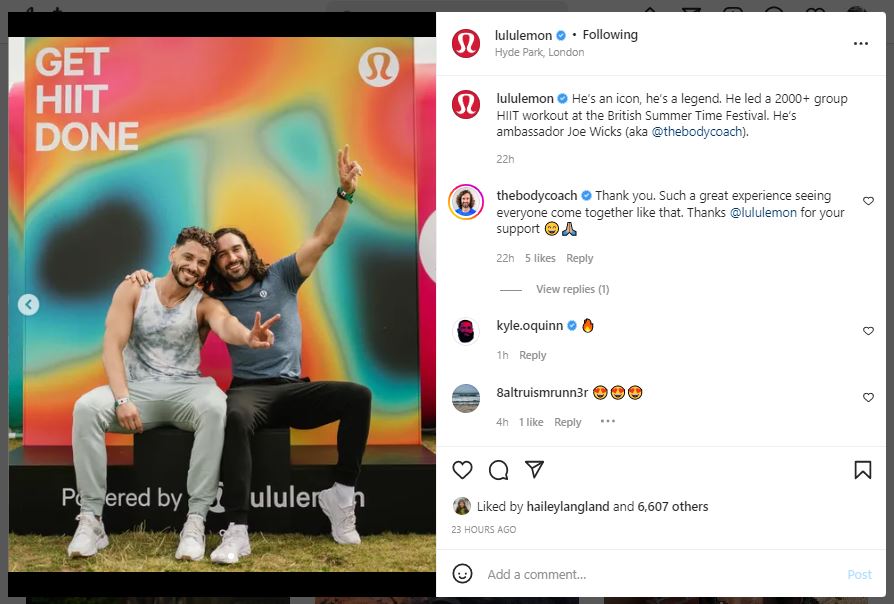
Tips for building a community:
- Create a private Facebook group. Invite your customers to join and post content and offers exclusive to the group. Include blog posts and videos to spur discussion.
- Reward your most active participants. Publicly recognize customers who frequently enhance the quality of discussions and post helpful feedback. Send them a special discount code or free gift as a thank you.
How to measure customer loyalty
The five metrics below will help you identify how loyal your customers are and which customer segments offer the best return on investment (ROI).
Customer lifetime value
Customer lifetime value (CLV) measures the revenue you can expect to earn from a customer over the entire duration of their relationship with your business. It’s a way for brands to measure the value of a customer.
CLV is important because it helps merchants determine how much they should invest in acquiring and retaining customers. For example, if you know a customer’s CLV is $100, you know not to spend more than this to acquire and retain the shopper. Doing so might actually cost you money.
Additionally, a high customer lifetime value can be a competitive advantage. A high CLV means you can spend a greater portion of your budget to acquire customers.
While there are many ways to measure CLV, this is a common formula:
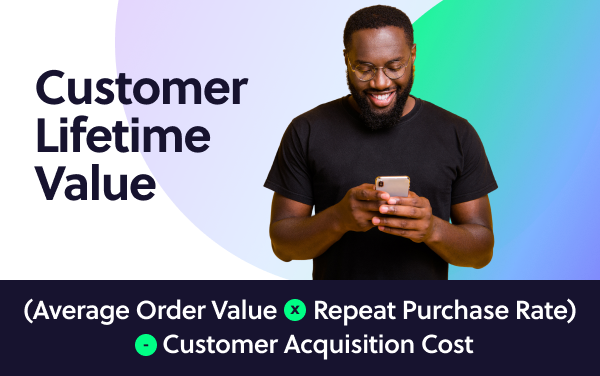
Net promoter score
Net promoter score (NPS) measures the willingness of current customers to recommend a company’s product or service. With NPS scores, you can take a strategic approach to improving customer relationships.
NPS scores are generated with a single-question survey that asks customers how likely they are to recommend a product, service, or organization on a scale from 0 (not at all likely) to 10 (extremely likely).
Customers are then divided into one of three categories depending on their response:
- 0–6: Detractors
- 7–8: Passives
- 9–10: Promoters
Promoters are loyal customers. Passives are satisfied customers. Detractors are unhappy customers.
Your NPS score is the percentage of promoters minus the percentage of detractors.

You should aim for an NPS of 30 or above.
Customer loyalty index (CLI)
Similar to NPS, CLI is a standardized metric that is derived from customer surveys. It’s used to measure the degree of brand loyalty. Unlike NPS, however, CLI asks multiple questions and focuses on repeat purchases and multiple purchases, in addition to recommendations.
Customers are asked to answer three questions on a scale from 1 (definitely yes) to 6 (definitely no). The questions are:
- How likely are you to recommend us to your friends and family?
- How likely are you to buy from us again in the future?
- How likely are you to try our other products?
A merchant’s CLI is the average score of the three questions using this scale:
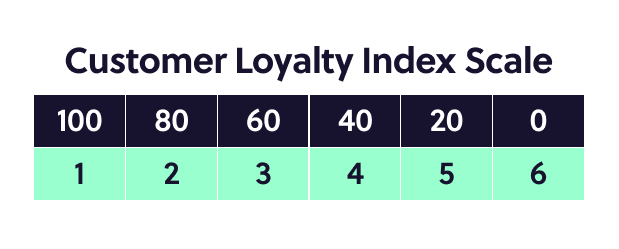
Repurchase rate
Repurchase rate is the percentage of customers who placed another order within a particular time frame. Typically, repurchase rate is calculated 30/60/90/180/360 days from first order. Also, note that multiple items purchased in a single order don’t count.
Repurchase rate is important for two reasons:
- It tells you how many repeat customers you have, which provides insights into the shoppers you should spend more time acquiring and retaining.
- It provides insights into which of your products are popular.
The formula:
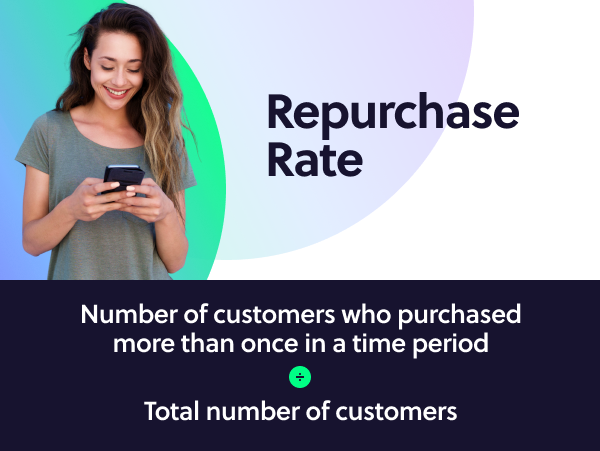
Upselling ratio
Upselling is a sales technique to get customers to increase their average order value by purchasing upgrades or premium versions of a product or service. Upselling is distinct from cross-selling, which is when a company offers customers a related product or service.
Upselling ratio is a straight-word metric. It measures how many customers are increasing their total spend with your organization. It’s a simple way to gauge customer loyalty, as customers who trust your brand and products tend to purchase more.
How to measure your upselling ratio:
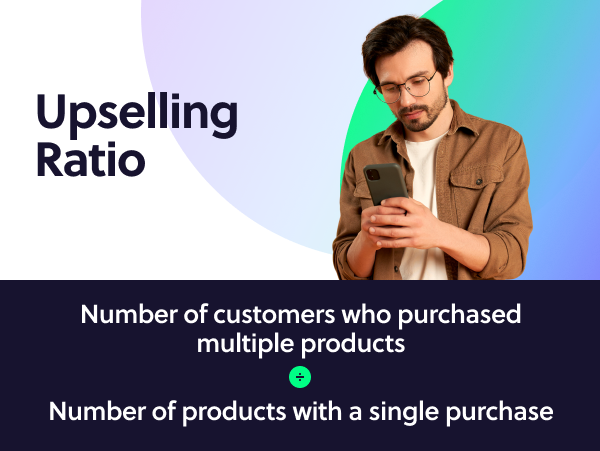
Boost eCommerce customer loyalty with subscriptions
Of all strategies to boost customer loyalty, the subscription model best captures what aspiring brand advocates seek. It brings together a product or service customers regularly use with the convenience and sense of community that keeps them coming back.
What to know more about subscriptions?
Check out our nine-part guide. It contains everything you need to know to launch and optimize your subscription experience.